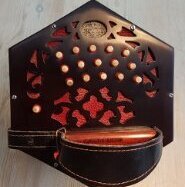-
Posts
1,633 -
Joined
-
Last visited
About alex_holden
- Birthday 02/06/1980
Contact Methods
-
Website URL
http://www.holdenconcertinas.com/
Profile Information
-
Gender
Male
-
Interests
Wood carving, metalwork, Morris Minors, folk music.
-
Location
Lancashire, England
Recent Profile Visitors
5,261 profile views
alex_holden's Achievements

Heavyweight Boxer (5/6)
-

Advice for thickness of leather for bellows
alex_holden replied to Rod Pearce's topic in Instrument Construction & Repair
I've never used a handheld knife for splitting. I used to use my Scharffix 2000 for both skiving and splitting, but since I invested in a vintage Fortuna bell skiver I now do the majority of it with that and reserve the Scharrfix for a couple of delicate tasks that the Fortuna struggles with (it has a bad habit of mangling very thin soft leather). The main thing I still use a handheld knife for is skiving the narrow ends of the top and end run strips. I think 'split' or maybe 'pare' is technically correct when the blade is held parallel to the leather to uniformly make it thinner, and 'skive' when it's tilted over to produce a feathered edge, but I often write 'skive' for both techniques (and use a 'skiving machine' to do both tasks). -

Advice for thickness of leather for bellows
alex_holden replied to Rod Pearce's topic in Instrument Construction & Repair
I use those for actual cutting, but in my experience if you try to skive on one, the blade digs in and shaves little slivers of plastic off the surface. -
alex_holden started following How Thick are Metal Ends? , Advice for thickness of leather for bellows , FYI on Importing Concertinas into USA and 6 others
-

Advice for thickness of leather for bellows
alex_holden replied to Rod Pearce's topic in Instrument Construction & Repair
What sort of work surface are people using to skive onto with a handheld knife? I sometimes use a sheet of glass but it seems to dull the edge and the leather slips too easily. More often I use a sacrificial piece of wood, which gets chewed up in the process and produces annoying splinters. I've heard of leatherworkers using a lithographic stone, but I don't have one of those. I've tried using a very fine Arkansas oil stone (the same one I use to put the final polish on the edge of the knife), and that seemed to work fairly well but I worried it might be a bad idea for the longevity of both the blade and the stone. -

FYI on Importing Concertinas into USA
alex_holden replied to Matthew Heumann's topic in General Concertina Discussion
9205.90.18 "Accordions and similar instruments: other", which has a duty rate of 2.6% from most countries of origin including the UK. -
About playing fast: it may not be entirely down to your technique. If you are starting out with a low-end instrument, many of them simply don't respond quickly enough to allow you to play fast. Most beginners, if they aren't completely put off the instrument, quickly find themselves wanting to upgrade to something more mid-range. You can't damage the instrument by playing multiple notes at once. Some playing styles particularly emphasise the use of chords. You will find though that the bellows run out of air faster than when playing in a single note melodic style.
-

a short rant about trying to sell stuff...
alex_holden replied to seanc's topic in General Concertina Discussion
That's really bad behaviour. I had a situation once where I saw a used tool on Facebook Marketplace, messaged the seller, agreed to buy it at the advertised price (I don't like haggling), and arranged to collect it at a particular time the next morning. When I got there on time, cash in hand, he told me he'd already sold it ten minutes earlier. It seems that he was fed up with Marketplace buyers not turning up when they said they would, so when two (or maybe more?) buyers said they wanted it, he agreed to sell it to both of us, and the first to arrive got it. He didn't seem to understand how rude that was. -
Thanks Geoff, that's very interesting. Here is the direct link to the auction lot: https://www.the-saleroom.com/en-gb/auction-catalogues/auction-team-breker/catalogue-id-breker10039/lot-ec63695b-e762-42e3-a857-b12601235875 Their description: Claude the Clown Musical Automaton by Gustave Vichy, c. 1890 Depicting a clown jauntily playing the concertina atop a banded wood barrel, with plaster-composition character head decorated with painted colored discs, articulated eyes, nose and right foot, the going-barrel motor with six cams and single-air cylinder movement causing Claude to turn and nod his head, move both hands and tap his foot as his eyes dart from left to right and his nose moves in and out in time to the music, dressed in checked silk breeches and magenta satin tailcoat trimmed with lace, ht. 26 in. (66 cm), good working condition, cylinder movement an old replacement, baseboard of barrel replaced, with bone-handled crank and Vichy acorn-form stop / start. - Literature: For similar pieces, see: Christian and Sharon Bailly, "Automates Anciens", exhibition at the Hospice Saint-Charles, 25. Nov.-30. Dec. 1995; Andrea Robertson, "Museum of Automata", p. 38. - With his lopsided grin, raised eyebrows and unique articulated nose, which mimics the folds and the movements of the concertina, "Claude" has one of the most remarkable faces in the Vichy oeuvre. The automaton was not illustrated in the Vichy catalog and surviving examples are exceedingly rare. We know of only four others: one in the former Museum of Automata in York, England, one exhibited at the Hospice Saint-Charles in Paris in 1995 and two in private European collections. And here is the accompanying video: I have saved a copy of the photos in case they get taken down after the auction.
-
In theory you shouldn't have to pay any extra fees because the eBay shipping system charged you in advance. Good luck with your new instrument!
-

Concertina maintenance kit in the U.S?
alex_holden replied to Azalin's topic in Instrument Construction & Repair
I think Wally probably meant "I agree with this statement". It's a common shorthand on social media. -
I met Willie a few years ago when he came over to England and he's a good bloke, very thoughtful and detail-oriented. He has spent a lot of time quietly building up his skills and tools. I believe he makes all the parts himself including Jeffries-style traditional concertina reeds. Frankly I am surprised he isn't more well known yet.
-

Tutorial Video Luke Hilman Orange Blossom
alex_holden replied to JoachimDelp's topic in Teaching and Learning
He's on the forum as @Luke Hillman -

How Thick are Metal Ends?
alex_holden replied to Cathasach's topic in Instrument Construction & Repair
Depends on the strength of the metal and how delicate the design is. I have used 0.7mm nickel silver with very fine fretwork and 1.2mm 5251-H22 aluminium alloy with slightly heavier fretwork (in hindsight I could probably have got away with 1mm). I imagine stainless steel ends could be a little thinner, maybe 0.6 or 0.5mm? Brass would be similar to nickel silver. -
LuukSnijder started following alex_holden
-
I see, I didn't realise you were talking about punching the rivet holes in the reed tongue. I assumed you were planning to make brass tongues to match the originals, so drilling holes in them wouldn't be difficult. I agree that drilling tempered spring steel may be a problem. If making brass tongues I would be inclined to look for some way to temporarily clamp or glue the tongue in position over the slot while you drill the holes, then remove and fit the rivets.
-
1/16" (1.58mm) rivets are commonly available in the UK in brass, or steel. You'll probably need to shorten them. https://www.ekpsupplies.com/1/16-x-1/2-steel-rivets-qty-50.html https://www.ekpsupplies.com/1/16-x-1/2-brass-rivets-qty-50.html By punch, do you mean one that forms a head on the rivet? I once made one from a cheap nail punch by grinding a small hollow into the tip using a diamond-coated ball bit in a rotary tool.
-
Interesting fretwork design. Does yours have aluminium reed frames too? The modern process for refining the metal was invented in 1886 and the first factory using the process opened in 1888. Prior to that it was very difficult and expensive to refine. If Lachenal was already experimenting with it by the 1890s that was a pretty innovative move. Initially they were probably using pure aluminium, which is quite soft and weaker than later alloys.







.thumb.jpeg.09943e9e2f2a23918324c6151aa2597b.jpeg)


